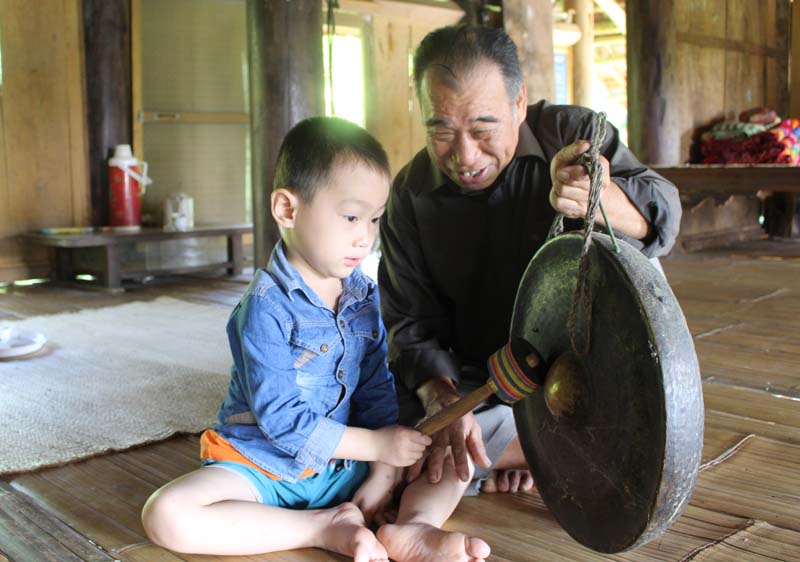


 Mr. Bui Van Khan – the artisan of gong in Luy Ai hamlet,
Phong Phu commune (Tan Lac) is teaching gong to the small children in the
hamlet.
Mr. Bui Van Khan – the artisan of gong in Luy Ai hamlet,
Phong Phu commune (Tan Lac) is teaching gong to the small children in the
hamlet.
Gong calmly sees off the dead souls to their ancestors ... Thus, over the time the sounds of gongs have become the indispensable cultural features in the spiritual life of Muong Bi people. Therefore, the Party Committee and the authorities of Tan Lac district have always been trying to preserve and promote the value of Gong in recent years.
Mr. Bui Van Khan – the artisan of Gong in Luy Ai hamlet, Phong Phu commune says that a set of gongs of Muong people consists of 12 pieces representing 12 months of the year and a full rotation of 4 seasons, spring - summer - autumn - winter. Twelve gongs create 12 separate sounds and at the same time they form a set of gongs with unique harmonies.
Luy Ai hamlet, Phong Phu commune is place which preserves most gongs in Tan Lac district. Most of the houses in the hamlet have from 1 to 2 gongs. Children in the hamlet are passionate about learning how to play gongs, many children at the age of 5 and 6 have already mastered simple lessons of gongs. To conserve Muong gongs, Luy Ai Ai hamlet has cooperated with the party committee and the authorities of Phong Phu commune to organize training courses to teach gong skills to the younger generation. After the gong courses, the young generation in the commune has confidently performed Muong gong at major festivals of the commune and district.
According to statistics, there are about 1,000 gongs in Tan Lac district now. Most of Muong ethnic people in Tan Lac know how to play gongs. Some communes have a large number of gongs such as Phong Phu, Ngoi Hoa, Man Duc ... All the communes in Tan Lac district have set up their own gong teams to perform in important commune events.
In the traditional festivals of Muong Bi people, it is indispensable to have the sounds of gongs to open the festivals. Muong gongs exist at all festivals of Muong Bi such as Khai Ha Ceremony in Muong Bi (the ceremony to start the new crop), the Open Ceremony to the Field, Spring Fishing Festival in March ... In which, Khai Ha Festival in Muong Bi takes place with the unique Muong performance of several hundred artisans of gong. When the sound of "Gong" bursts out, the festival officially starts ...
Tan Lac is one of the districts that still retains a large number of gongs in the province. The charming girls of Muong Bi are the core force participating in gong performance at major events of the province such as: 130th anniversary of the provincial establishment, 25 years of the provincial re-establishment, the Olympic ... The participation in gong performance at major events in the province has contributed to promoting the storage of Muong ethnic musical instruments. In addition, in order to conserve Muong gongs, Tan Lac district has also been paying attention to establishing mass performance teams at the community tourist destinations such as Ban Ngoi (Ngoi Hoa commune), Chien hamlet (Nam Son commune), Luy Ai hamlet (Phong Phu commune) ...
Mr. Dinh Xuan Tung, the Department of Culture and Sports of Tan Lac district, says that gongs unite the friendship of the neighbors keep the soul for Muong land. Therefore, the Party Committee and the authorities of Tan Lac district always pay great attention to preserving and developing Gong culture. In order to preserve and promote the value of gongs, the Party Committee and the authorities of Tan Lac district have always actively organized propaganda among the people about the sense of preserving and promoting the value of gong culture.
The district’s Department of Culture and Sports has closely cooperated with the communes to keep an inventory of the number of gongs in the area. They have been honoring the gong artisans and mobilizing them to participate in teaching gongs to the younger generation in the hamlets and communes. Besides, the district often opens classes to teach the skills to play gongs. They have also been paying attention to developing the mass art movement at the grassroots level to bring gong items in competitions and shows.